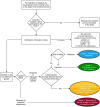Postadychute-AG, Detection, and Prevention of the Risk of Falling Among Elderly People in Nursing Homes: Protocol of a Multicentre and Prospective Intervention Study
- PMID: 34713067
- PMCID: PMC8521935
- DOI: 10.3389/fdgth.2020.604552
Postadychute-AG, Detection, and Prevention of the Risk of Falling Among Elderly People in Nursing Homes: Protocol of a Multicentre and Prospective Intervention Study
Abstract
Introduction: While falls among the elderly is a public health issue, because of the social, medical, and economic burden they represent, the tools to predict falls are limited. Posturography has been developed to distinguish fallers from non-fallers, however, there is too little data to show how predictions change as older adults' physical abilities improve. The Postadychute-AG clinical trial aims to evaluate the evolution of posturographic parameters in relation to the improvement of balance through adapted physical activity (APA) programs. Methods: In this prospective, multicentre clinical trial, institutionalized seniors over 65 years of age will be followed for a period of 6 months through computer-assisted posturography and automatic gait analysis. During the entire duration of the follow-up, they will benefit from a monthly measurement of their postural and locomotion capacities through a recording of their static balance and gait thanks to a software developed for this purpose. The data gathered will be correlated with the daily record of falls in the institution. Static and dynamic balance measurements aim to extract biomechanical markers and compare them with functional assessments of motor skills (Berg Balance Scale and Mini Motor Test), expecting their superiority in predicting the number of falls. Participants will be followed for 3 months without APA and 3 months with APA in homogeneous group exercises. An analysis of variance will evaluate the variability of monthly measures of balance in order to record the minimum clinically detectable change (MDC) as participants improve their physical condition through APA. Discussion: Previous studies have stated the MDC through repeated measurements of balance but, to our knowledge, none appear to have implemented monthly measurements of balance and gait. Combined with a reliable measure of the number of falls per person, motor capacities and other precipitating factors, this study aims to provide biomechanical markers predictive of fall risk with their sensitivity to improvement in clinical status over the medium term. This trial could provide the basis for posturographic and gait variable values for these elderly people and provide a solution to distinguish those most at risk to be implemented in current practice in nursing homes. Trial Registration: ID-RCB 2017-A02545-48. Protocol Version: Version 4.2 dated January 8, 2020.
Keywords: balance quantification; elderly people; fall; physical activity; prediction.
Copyright © 2021 Quijoux, Bertin-Hugault, Zawieja, Lefèvre, Vidal and Ricard.
Conflict of interest statement
The authors declare that the research was conducted in the absence of any commercial or financial relationships that could be construed as a potential conflict of interest.
Figures


Similar articles
-
Erratum.Mult Scler. 2016 Oct;22(12):NP9-NP11. doi: 10.1177/1352458515585718. Epub 2015 Jun 3. Mult Scler. 2016. PMID: 26041800
-
Posturography and risk of recurrent falls in healthy non-institutionalized persons aged over 65.Gerontology. 2006;52(6):345-52. doi: 10.1159/000094983. Epub 2006 Aug 11. Gerontology. 2006. PMID: 16905886
-
Are activity-based assessments of balance and gait in the elderly predictive of risk of falling and/or type of fall?J Am Geriatr Soc. 1993 May;41(5):479-87. doi: 10.1111/j.1532-5415.1993.tb01881.x. J Am Geriatr Soc. 1993. PMID: 8486878
-
Exercise for preventing falls in older people living in the community.Cochrane Database Syst Rev. 2019 Jan 31;1(1):CD012424. doi: 10.1002/14651858.CD012424.pub2. Cochrane Database Syst Rev. 2019. PMID: 30703272 Free PMC article.
-
The contribution of postural balance analysis in older adult fallers: A narrative review.J Bodyw Mov Ther. 2016 Apr;20(2):409-17. doi: 10.1016/j.jbmt.2015.12.008. Epub 2015 Dec 18. J Bodyw Mov Ther. 2016. PMID: 27210860 Review.
References
-
- WHO . WHO Global Report on Falls Prevention in Older Age. World Health Organization. (2008).
-
- Bourdessol H, Pin S. Réseau francophone de prévention des traumatismes et de promotion de la sécurité. Institut national de prévention et d'éducation pour la santé. In: Prévention des chutes chez les personnes âgées à domicile: référentiel de bonnes pratiques. Saint Denis: Editions Inpes; (2005). p. 30–3.
-
- HAS . Analyse de la Posture Statique et/ou Dynamique sur Plate-Forme de Force (Posturographie). Service Evaluation des Actes Professionnels; (2007).
LinkOut - more resources
Full Text Sources
Medical

